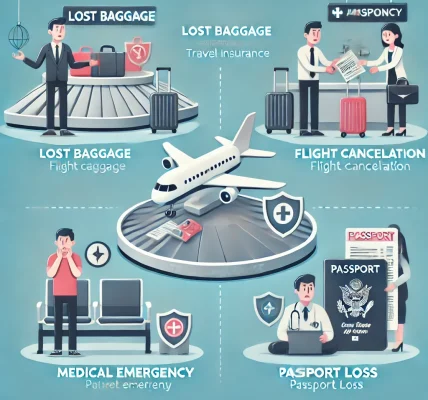Introduction
For frequent travelers, purchasing individual travel insurance policies for every trip can be costly and inconvenient. Multi-trip travel insurance, also known as annual travel insurance, provides coverage for multiple journeys within a specified period, typically one year. This type of insurance not only simplifies the process but can also lead to significant cost savings.
In this guide, we will explore how multi-trip travel insurance works, its benefits, cost-saving advantages, and how to choose the right policy for your needs.
What is Multi-Trip Travel Insurance?
Multi-trip travel insurance is a policy designed for travelers who take multiple trips per year. Instead of purchasing a separate policy for each trip, a single policy covers all travel within a set duration, usually 12 months. Policies may have limits on the length of each individual trip, typically ranging from 30 to 90 days.
Key Benefits of Multi-Trip Travel Insurance
1. Cost Savings
- Purchasing a single policy for multiple trips is often more affordable than buying separate policies for each trip.
- It eliminates the recurring administrative fees associated with single-trip insurance.
2. Convenience and Time-Saving
- No need to repeatedly apply for new policies before each trip.
- Instant coverage for spontaneous travel plans without extra paperwork.
3. Comprehensive Coverage
- Typically includes medical expenses, trip cancellations, baggage loss, and travel disruptions.
- Some policies include coverage for activities like skiing, hiking, and other adventure sports.
4. Flexibility for Frequent Travelers
- Ideal for business travelers, digital nomads, and leisure travelers who take multiple vacations per year.
- Provides coverage for both domestic and international travel.
How Multi-Trip Travel Insurance Saves You Money
1. Lower Cost Per Trip
If you travel more than twice a year, the cost of multi-trip insurance is often lower than purchasing multiple single-trip policies. The more trips you take, the greater the savings.
2. Covers Unexpected Cancellations and Delays
- Trip cancellations due to unforeseen circumstances can lead to financial losses. Multi-trip insurance provides reimbursement for non-refundable expenses.
- Delays and missed connections can result in additional costs, which are typically covered by the policy.
3. Medical Expenses Coverage
- Emergency medical expenses abroad can be extremely high. Multi-trip policies ensure you are covered every time you travel.
- Some policies offer coverage for pre-existing conditions, reducing the risk of unexpected out-of-pocket medical costs.
4. Baggage and Personal Belongings Protection
- Lost, stolen, or delayed baggage can lead to expenses for replacement items.
- Multi-trip insurance often includes baggage protection, saving you from unexpected spending.
5. Savings on Adventure Sports Coverage
- Many single-trip policies charge extra for covering adventure activities like scuba diving or skiing.
- Some multi-trip plans include adventure sports coverage at no additional cost.
Who Should Consider Multi-Trip Travel Insurance?
- Business Travelers: Professionals who frequently travel for work can benefit from year-round coverage.
- Frequent Leisure Travelers: If you take three or more vacations per year, multi-trip insurance is a cost-effective option.
- Digital Nomads and Remote Workers: Those who work remotely while traveling can ensure continuous coverage.
- Students and Exchange Program Participants: Ideal for students who frequently travel between countries.
How to Choose the Right Multi-Trip Travel Insurance
1. Evaluate Your Travel Frequency
- If you travel at least three times per year, multi-trip insurance is likely the most economical choice.
2. Check the Maximum Trip Duration
- Policies usually limit the duration of each trip (e.g., 30, 60, or 90 days). Choose one that aligns with your travel patterns.
3. Look for Comprehensive Coverage
- Ensure the policy includes medical expenses, trip cancellation, baggage protection, and emergency evacuations.
4. Compare Costs with Single-Trip Insurance
- Calculate the total cost of multiple single-trip policies and compare it to the cost of one multi-trip policy.
5. Consider Additional Coverage Options
- If you participate in adventure sports or carry expensive equipment, check if these are covered.
- Some policies include rental car insurance and travel assistance services.
How to Make the Most of Your Multi-Trip Travel Insurance
1. Understand Policy Terms and Conditions
- Read the fine print to know what is and isn’t covered.
- Check for any exclusions related to pre-existing medical conditions, high-risk activities, or certain destinations.
2. Keep Emergency Contact Information Handy
- Save your insurer’s contact details for quick assistance in case of an emergency.
3. Carry Proof of Insurance While Traveling
- Some countries require travelers to show proof of insurance upon entry.
- Keep a digital copy of your policy accessible at all times.
4. Stay Within the Trip Duration Limit
- Exceeding the maximum trip duration can void your coverage. Plan trips accordingly.
5. Report Claims Promptly
- If you experience an issue, notify your insurer as soon as possible.
- Provide necessary documentation for a smooth claim process.
Conclusion
Multi-trip travel insurance is a smart investment for frequent travelers, offering cost savings, convenience, and comprehensive coverage. By choosing the right policy, understanding its terms, and maximizing its benefits, you can travel stress-free while saving money.
Before purchasing, compare policies, assess your travel needs, and ensure you get the best value for your trips. With the right multi-trip travel insurance, you can focus on enjoying your journeys without worrying about unexpected expenses.




